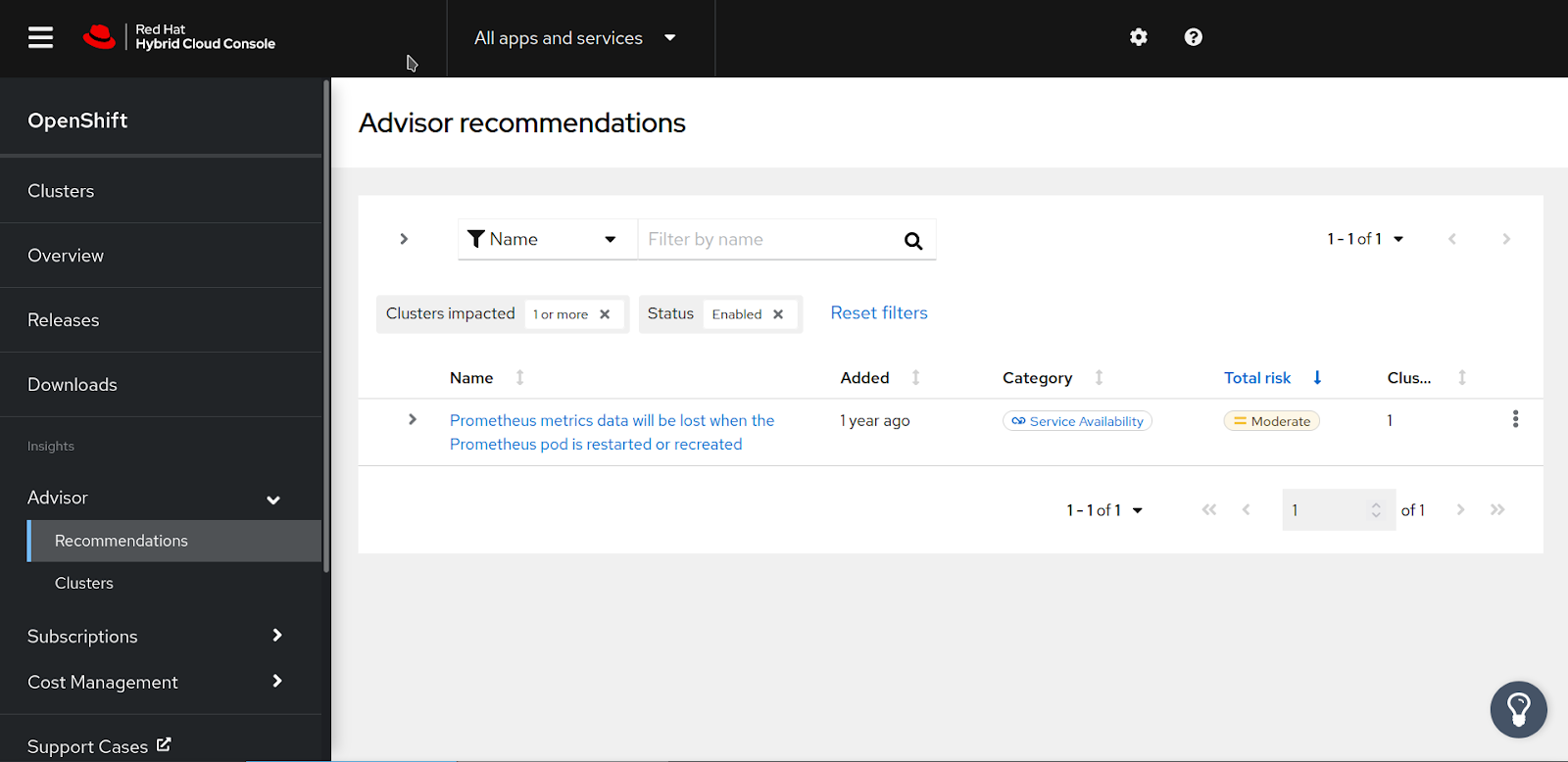Insights Advisor for OpenShift was introduced almost two years ago and its user interface was tightly integrated with Red Hat Hybrid Cloud Console (formerly OpenShift Cluster Manager). We’ve gained a lot of feedback from our customers and with Red Hat OpenShift 4.10, and we are introducing a completely redesigned UI that brings new views on recommendations and allows easier navigation between recommendations, impacted clusters and remediations.
We’ll walk through some of the new features in this post.
What is Insights Advisor?
Red Hat Insights, which is included with Red Hat subscriptions, analyzes platforms and applications to help enterprises manage hybrid cloud environments. Insights uses predictive analytics and deep domain expertise to reduce complex operational tasks from hours to minutes, including identifying security and performance risks, tracking licenses, and managing costs.
Specific to Red Hat OpenShift, the goal of these services is to improve operational experience with OpenShift clusters by combining analytical data from clusters with Red Hat experience in operating and supporting OpenShift environments.
One of the services is Insights Advisor for OpenShift, a service that provides recommendations to prevent future problems or to mitigate existing problems in your environment. Advisor analyzes your cluster for potential configuration, performance or scalability issues and security vulnerabilities, and offers specific remediation steps to avoid or resolve given issues.
There’s no need for additional configuration on a cluster—as long as your cluster can connect to the internet—Insights Advisor is available to you. Some examples of recommendations can be found in my earlier blog post, Your OpenShift Cluster, Health Checks, Insights and You.
We made it easier to find Insights Advisor
The most important thing to be aware of is that the Advisor service has moved. The results of Insights analysis are no longer available within the Cluster Details page. Instead, Advisor has its own menu item on the left-hand navigation bar of the Hybrid Cloud Console, where you’ll also find Subscriptions and Cost Management.

We made sure this transition is as smooth as possible, and all existing integrations within Hybrid Cloud Console (including the widget on the Cluster Overview and Cluster Detail pages, OpenShift Web Console and Red Hat Advanced Cluster Management for Kubernetes integrations) are still working.
Filter to recommendations that are most important for your infrastructure
The main page of Advisor service is the Recommendations page. This page lists all recommendations that are currently available for your set of clusters. Recommendations have different categories (Service Availability, Performance, Fault Tolerance and Security) and different risk levels that indicate severity as well as potential impact of the remediation. The new UI allows you to filter and sort recommendations to focus on those that are important to you and your infrastructure.
After opening a specific recommendation, a list of all affected clusters is shown. Additional details about the recommendation are also shown, including links to various sources of relevant context such as OpenShift documentation , Red Hat Knowledgebase articles or Bugzilla bugs. To find specific and tailored remediation steps, you need to select one of the affected clusters. You can apply cluster-specific steps listed under “Steps to resolve.”.

The second new view shows all clusters that are being processed by Insights and that have recommendations available. This allows you to view clusters with multiple recommendations or clusters that have recommendations of a high severity where remediation should be prioritized or addressed immediately. Once opening the specific cluster, you’ll see all recommendations available on a single page that again allows additional sorting and filtering.
Some of the recommendations might not be important for your setup. Recommendations that are of a lower severity often point at best practices and recommended architecture. There might be a good reason why you don’t and can’t follow those recommendations. For that reason, you are able to disable recommendations. This can be done either for all clusters on the Recommendations page or just for a single cluster. The recommendation will not show by default in any of the views but can be enabled by turning it on in filters.
If you want to be notified immediately about new available recommendations, the Hybrid Cloud Console features eventing and notifications options. This way, you can configure instant notifications to email or to a webhook (and eventually Slack, Salesforce and other places). You’ll find more about notifications configuration in the blog post Never Miss Important Fixes for Your OpenShift Cluster With Notifications and Alerts.
Give it a try
As always, we’re looking for feedback and your experience with Red Hat Insights. Please reach out by sending email to insights@redhat.com or by using the Feedback button (the bulb icon on the bottom right-hand side of the Advisor service). Please be sure to check this out and give the new Insights Advisor a try!
저자 소개
Radek Vokal started with Red Hat in 2004 as a software engineer, later lead team responsible for core Red Hat Enteprirse Linux components and core Kubernetes teams. Currently he is the Senior Manager of Product Management for Insights OpenShift services and is based in Brno, Czech Republic.
유사한 검색 결과
Red Hat's commitment to the EU Cyber Resilience Act: Shaping the future of cybersecurity standards
Data-driven automation with Red Hat Ansible Automation Platform
Technically Speaking | Platform engineering for AI agents
Technically Speaking | Driving healthcare discoveries with AI
채널별 검색
오토메이션
기술, 팀, 인프라를 위한 IT 자동화 최신 동향
인공지능
고객이 어디서나 AI 워크로드를 실행할 수 있도록 지원하는 플랫폼 업데이트
오픈 하이브리드 클라우드
하이브리드 클라우드로 더욱 유연한 미래를 구축하는 방법을 알아보세요
보안
환경과 기술 전반에 걸쳐 리스크를 감소하는 방법에 대한 최신 정보
엣지 컴퓨팅
엣지에서의 운영을 단순화하는 플랫폼 업데이트
인프라
세계적으로 인정받은 기업용 Linux 플랫폼에 대한 최신 정보
애플리케이션
복잡한 애플리케이션에 대한 솔루션 더 보기
가상화
온프레미스와 클라우드 환경에서 워크로드를 유연하게 운영하기 위한 엔터프라이즈 가상화의 미래
